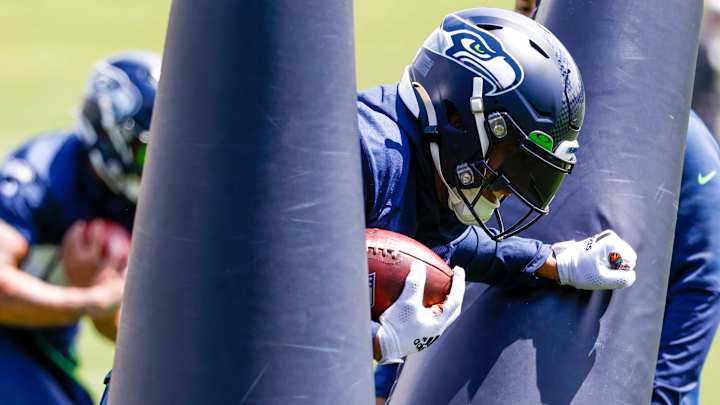Cade Johnson Should Not Be Overlooked in Seahawks' Receiver Competition

In this story:
The Seahawks have some truly intriguing depth pieces at the receiver position. Shortly after using a pair of seventh-round draft picks on rookie pass catchers Bo Melton and Dareke Young, Seattle went on to add veteran speedster Marquise Goodwin to a group already bolstered by familiar faces like Cody Thompson and Penny Hart.
Between those five names, the competition for one—maybe two—roster spot(s) is already quite congested. But the Seahawks have even more wideouts capable of making some noise in training camp, including second-year man Cade Johnson.
The 2021 undrafted free agent was a three-year standout at South Dakota State and put together an impressive Senior Bowl showing. Unfortunately for him, a lackluster followup at his pro day—partnered with concerns about his size and small-school experience—led him to the open market on draft week.
Often compared to Seahawks legend Doug Baldwin, Johnson's fit in the Pacific Northwest was natural. Seattle's receiving corps had struggled to create after the catch in 2020 and the skilled route runner's college track record suggested he could potentially offer a solution to that issue.
Johnson, however, kicked off his NFL career by sustaining a groin injury during rookie minicamp. Although the ailment didn't prove too serious, it set the tone for an underwhelming summer.
As a whole, Seattle's first two preseason games were forgettable at best. Starting quarterback Russell Wilson did not take a single snap in either affair and incumbent backup Geno Smith exited the first game and missed the second with a concussion. This put Johnson's hopes of making the active roster on the arms of Sean Mannion and Alex McGough, who went a combined 35 of 57 passing for 297 yards, one touchdown and two interceptions over that stretch.
The Seahawks scored a total of 10 points in those games, but they fared a lot better in their preseason finale with the Chargers. In a 27-0 shutout of L.A., Smith returned and Mannion played well as the offense found the end zone twice. That said, Johnson did not contribute much to the action, reeling in just two targets for a modest 13 yards.
In all, Johnson caught nine of 12 passes for 72 yards and was cut as Seattle trimmed its roster down to 53 players. Interestingly, every other receiver he was seemingly competing with was also handed their walking papers as the team broke camp with a quartet of DK Metcalf, Tyler Lockett, Dee Eskridge and Freddie Swain.
As the year progressed, the Seahawks addressed their receiving situation on a week-to-week basis, keeping roster spots to a minimum and making use of practice squad elevations if deemed necessary. Injuries, such as the severe concussion that held Eskridge out for seven games, did occur and players like Hart and Thompson saw their fair share of time on the roster.
Johnson did not, however, despite signing back with Seattle's practice squad before Week 1. That's where he remained until Week 12, when he was released to make room for running back B.J. Emmons. Johnson's time away from the team did not last long, though, as he re-signed to the practice squad a week later. He went on to finish the season without further disruptions or promotions.
Signing a reserve/future contract with the Seahawks back in January, Johnson, as previously mentioned, has an uphill climb ahead of him this summer. But with his playmaking prowess and advanced technical ability—now reinforced by a year's worth of NFL coaching—he should pose a legitimate threat to Melton and other prospective receivers on the back end of Seattle's roster.
One could make the argument that Seattle's offense is now better tailored to Johnson's strengths than it was last season. This is thanks in large part to Wilson's exit and the well-documented impact his smaller build has on the throws he feels comfortable making and the concepts the team runs. Attacking the middle of the field and being efficient in quick game concepts had proved problematic for the Wilson-led Seahawks, and that was ultimately Johnson's bread and butter in college.
According to Pro Football Focus, Johnson lined up in the slot on 82.1 percent of his offensive snaps at South Dakota State and, on an average depth of target of 13.2 yards, recorded 1,522 of his 2,863 career receiving yards (53.1 percent) after the catch. In a system that can both scheme him into open spaces and let his route running shine, with a taller quarterback like Smith or Drew Lock throwing him the ball, Johnson could very well thrive.
Of course, special teams will also play a key role in determining who Seattle's fifth and/or sixth receiver will be, assuming such a job exists. Johnson, quite frankly, is behind the likes of Melton, Thompson and Hart in that department, though he could make up some ground if he proves useful in the return game.
Whatever the case may be, it should not come as a surprise if Johnson's name begins to generate some buzz around the Virginia Mason Athletic Center in July and August. Just because the Seahawks have acquired a few shiny new options doesn't necessarily mean they didn't have something better already parked in the garage. Johnson has a wealth of talent and a chip on his shoulder—a dangerous combination his peers will need to be weary of.

Reporter and editor covering the Seattle Seahawks for All Seahawks. Host of Locked On Mariners.
Follow danegnzlz